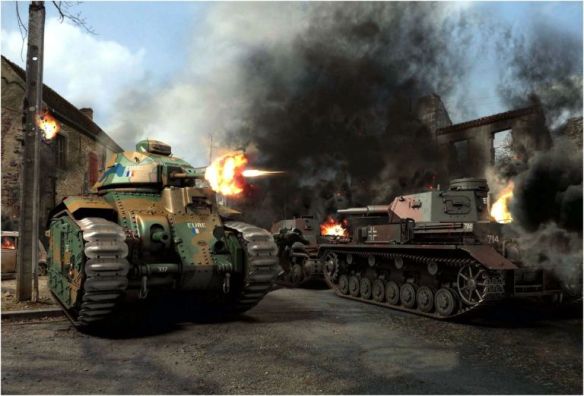The bitterest fighting during the campaign in the west erupted over the village of Stonne that changed hands 17 times between 15 and 17 May. Its geographic location tells us why, of all places, there was such furious fighting over this little village that numbered only a dozen farmsteads. The heavily wooded Mont-Dieu (God’s Mountain) rises steep and threatening just fifteen kilometers south of Sedan. This massif blocks the terrain to the south like a natural fortress. The village of Stonne stands exposed along the northeast edge, the highest and steepest point of this ridge. Right at the eastern edge of this settlement rises the conical Pain de Sucre, which the Germans called Zuckerhut (Sugarloaf), the best observation point far and wide, whose military significance had been recognized by the ancient Romans. Before the start of the campaign, the French had fortified the northern edge of this massif with pillboxes and barriers and had developed it into a blocking position. At the same time, they were able to exploit the terrain as a point of departure for an attack to the north. The struggle for this ridge at times took on the character of positional warfare of World War I. The French compared the “hell of Stonne” over and over again to the “hell of Verdun.” A German officer later said: “There are three battles that I can never forget: Stonne, Stalingrad, and Monte Cassino.” The fighting for Stonne was of great operational significance inasmuch as the Germans tried at this point to nip the French counterattack in the bud—a counterattack that was very dangerous to them. To that extent, it seems by no means an exaggeration to say that the Battle of Sedan was actually decided at Stonne.
Only two episodes will be picked out from among the confusing number of combat actions that took place after the decisive events of 15 May. In spite of the initial apparent success, these episodes clearly demonstrate one of the most important factors in the French defeat. The main body of two French tank battalions, supported by one infantry battalion, attacked the tiny village of Stonne around 0700 on 16 May after a forty-five-minute barrage from two artillery regiments. In the end, it was one single tank that took the village practically all by itself. Captain Billotte, commanding officer of the 1st Company, 41st Battalion, in his Char B Eure, broke through the German positions and pushed into Stonne. A German Panzer company from the 8th Panzer Regiment that had moved into positions on both sides of the village street now opened fire from all barrels. But the Char B drove smack through the column, shooting up all 13 German Panzers with its 4.7-cm and 7.5-cm guns and also wiping out two antitank guns. The Char B itself received 140 hits, but not a single one of the German projectiles penetrated its armor.
Char B Riquewihr of the 49th Tank Battalion spread even greater terror on the next day. Its commander, Lieutenant Doumecq, on that day was dubbed le boucher de Stonne (the butcher of Stonne) by his comrades. Around 1700 he attacked in the direction of Stonne. Some eight hundred meters to the northwest of the village, he ran into a column of German infantrymen who were seeking cover in a section of ditch along the way. When those infantrymen rather light-heartedly opened fire with their small arms, he simply rolled over the entire column. Then, firing wildly all around, he pushed into the village that was being held by men of the 64th Rifle Regiment. Those men panicked and fled from the village as they spotted the fire-spitting monster with its still-bloody tracks.
At this point the question arises: How could the inferior German Panzer force in just a few days simply overrun the French armored force, which had considerably more and better tanks and whose tankers in some cases fought with noticeable resolution? The most important answer has already been given with the example of Flavigny—the French did not know how to combine their tanks into a coherent action on the operational echelon. As demonstrated at Stonne, moreover, they could not do that even at the tactical echelon in the context of combined arms combat. Spectacular though the highly praised actions of Captain Billotte, Lieutenant Doumecq, and many others may have been, these were usually individual exploits that were nothing but piecework, as it were, and whose success in most instances could not be exploited.
The example of the feared French Char B tank demonstrated precisely the shortcomings of the French tank arm. To begin with, few tanks had radios. The quality of those radios was so poor that they frequently failed, especially in the case of protracted combat operations. In that way, the tank commanders were hardly in a position to coordinate their own operations not to mention joint actions with the infantry. On the other hand, almost all German Panzers were equipped with modern radios. Huge formations attacked as if governed by a single will. Whenever radio contact failed now and then, the principle of Auftragstaktik (mission-type tactics) took over. In that respect, what happened at Stonne was practically a tragedy. There were hardly any other major French units that fought with such self-sacrifice as the men of the French 3d Motorized Infantry Division and the 3d Armored Division. In the end, however, all this bravery was in vain because the French army was operating on the basis of an obsolete command system that had been handed down from World War I.
